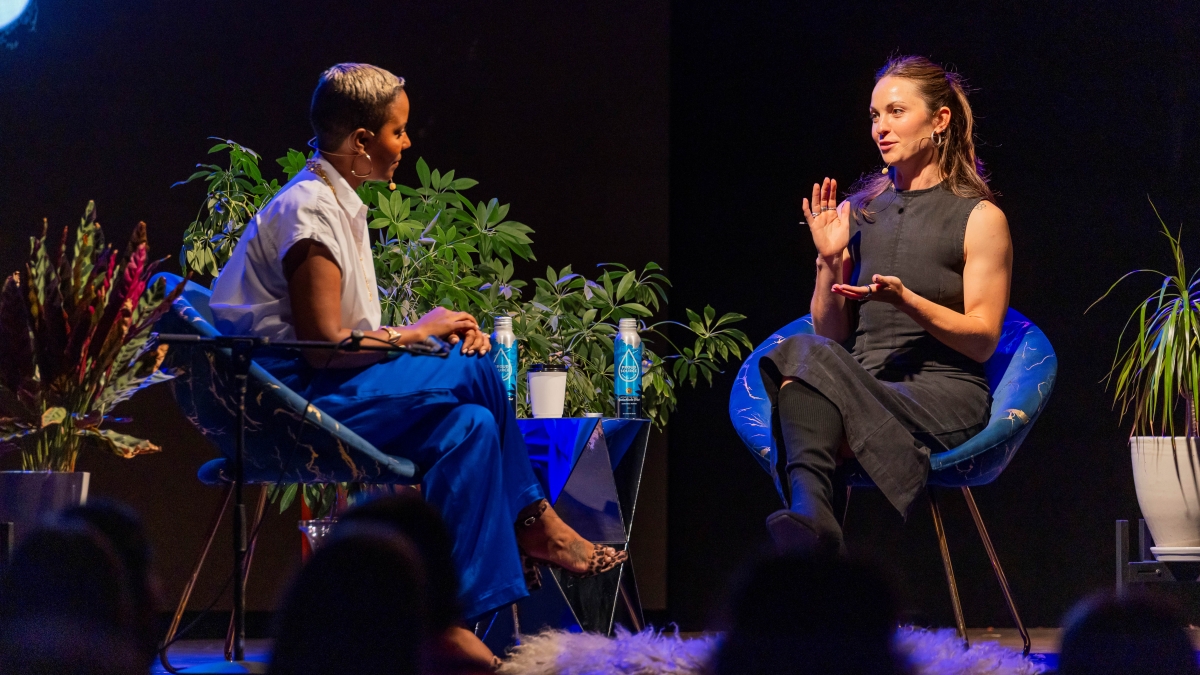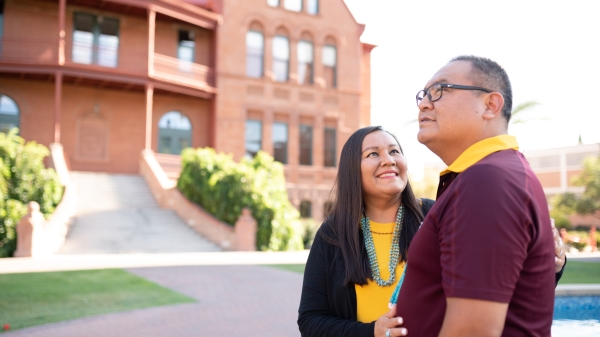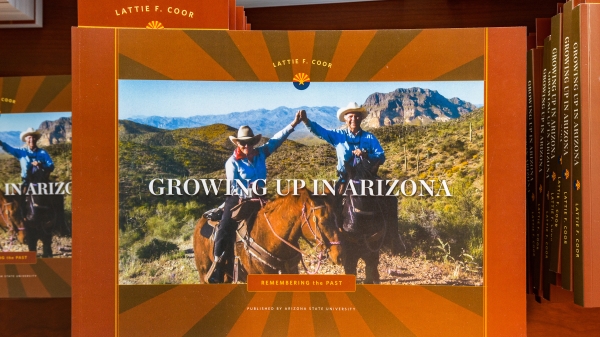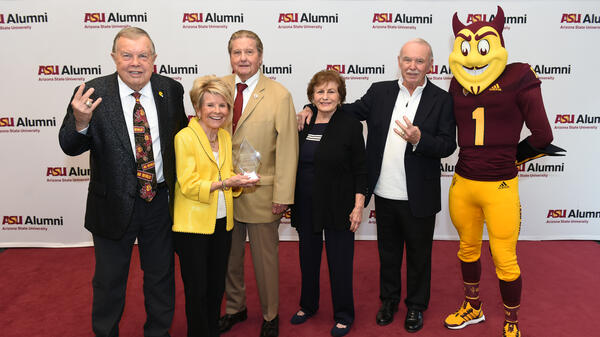ASU professor on how to have ‘critical conversations’
Abigail Henson's podcast is dedicated to deep, engaging discussions that challenge perspectives, cultivate critical thinking

Abigail Henson (right), an ASU criminology and criminal justice assistant professor, interviews author, psychologist and intergenerational trauma expert Mariel Buqué for an episode of Henson's podcast, "Critical Conversations with Dr. Abbie." Courtesy photo
The best approach for having a critical conversation is to prioritize listening and curiosity above being heard and being right, says an Arizona State University professor who hosts a podcast on the matter.
Assistant Professor Abigail Henson started her podcast just after arriving at ASU in 2020 as a new faculty member in the School of Criminology and Criminal Justice. In “Critical Conversations with Dr. Abbie,” Henson defines such conversations as the kind of discussions that get you to "think critically, challenge existing narratives and cultivate change through dialogue.”
Henson said her past guests have been “those who have been directly impacted by the criminal justice system, whether through lived experience, research or both.” But this year, she is devoting 10 episodes to 10 tools for engaging in a critical conversation.
It's the kind of conversation more people should learn how to have if they’re looking for solutions to problems, she said, especially in the nation’s currently polarized political and social climate, where give-and-take has, for many people, become a lost art.
We asked Henson to talk about critical conversations, when to have one and what to try to achieve with one.
Editor's note: Answers have been edited for length and clarity.
Question: What is a critical conversation? When would someone engage in one?
Answer: To me, it is a meaningful conversation that is crucial for growth and understanding, which is what makes it critical. To be honest, my definition might be different than yours, which is fine, because it is what is critical to you that matters.
It could be a difficult conversation, it could be a conversation that is hyper-connecting and loving, and therefore leads to a greater sense of community. Critical conversations are meaningful conversations that lead to positive outcomes, whatever definition of yours that is. For me, the positive outcome I’m seeking is enhanced connectivity, understanding and equity.
Q: You’ve said that behind each critical conversation is a desire to affect a change in how we see situations and how things are getting done. Often that means differences in identifying the path to solutions. How do participants move a critical conversation away from conflict and toward conciliation, compromise and, ultimately, solutions?
A: (One of my podcast guests was) Peter Coleman, a psychology professor at Columbia University and a conflict-resolution expert. He said there are tangible tools in what he called "taking a conversation for a walk." He suggests you “walk” in a way that allows you to look at the world, literally. Instead of you and I sitting across from each other at a table, we’re discussing things as us-and-everyone-else, instead of you-versus-me.
This concept of self-awareness is so key in moving away from conflict. You can catch yourself in moments of defensiveness and learn how to release your ego. You realize that another person’s position hasn’t anything to do with you, and more with the experiences and exposures and stories they’ve inherited.
Realize what makes conflict, conflict is misunderstanding. What turns conflict into a conversation is curiosity: Where you are explicit in your intentions in the conversation? The intention should not be to change minds, but to understand how you got there. Ask questions. Allow conversations to be a mirror and unpack those stories, exposures and experiences. Few people have the self-awareness to tell how they got from A to B, as so many of our positions are tied to identity.
Q: You use a technique with your students to teach them empathy for others with different viewpoints. Can you explain?
A: I take a topic, such as the death penalty or whether to maintain criminal records, and ask my students to take a position. They are usually pretty evenly split. I then divide the class by the position they chose and then, unbeknownst to them, assign each group to defend the opposing position. This allows them to see the potential arguments of the other side.
While, for some, the exercise might hone their original position, it also facilitates the opportunity for students to understand the complexity embedded within most topics and build empathy for those holding opposing views. It's an exercise to bridge divides and demonstrate that nothing is simply black-and-white — even those colors have shades and tones that bring them closer together on the chromatic scale, and I'm sure there are arguments among color scientists on what "true white" and "true black" are.
All of these positions are subjective and can change quickly with learned information or a shift in framing. So this exercise encourages students to be open and curious rather than dogmatic in their beliefs.
Q: Are there enough critical conversations going on in our society, workplaces, public life?
A: Definitely not enough. There’s a lot of conversation, but I don’t think there are a lot of critical conversations. Too many of us speak without critical thinking and without listening. There’s a lot of talking at (each other) rather than dialogue. We have forgotten how to listen, and in a lot of conversations occurring in workspaces or really anywhere, I believe we’re all going in already knowing what we’re going to say.
There needs to be openness, curiosity, a willingness to change and a willingness to fail. I think a large part of this, too, is what we want the outcomes of the conversation to be. Sometimes we come to an impasse because people are scared to take the step to implement the change being discussed, because they have a fear of failure. But you can’t grow and change without failure. A lot of conversations lack listening, self-awareness, curiosity, vulnerability, empathy. And I think so much of this has to do with our ego and our sense of identity.
(In the podcast, we say) here is how to be vulnerable, empathetic, how to be curious. All elements that lead to heightened innovation, better working groups, a sense of community — they’re all part of the tool kit. They are so important, because the way we have learned to communicate is incredibly divisive.
Q: How would you advise someone wanting to make a first effort at a critical conversation?
A: There are different levels. On a more kind of concrete, higher level: What is the space where you want to have the conversation? What is the noise level? Is there construction going on, are you in a loud restaurant? Your surroundings affect your nervous system. Consider a calming element to ground you while having this conversation. Or surround your space with gentle sound that assists you in cultivating comfort.
Then, you want to enter the conversation with some thought already. Do a little research. If you’re thinking about something, bring in some data; say, I read this, I heard this podcast, here’s what they said, I’m curious what you think. And be open to hearing it. Actually listen.
One of the podcast episodes is on listening versus hearing. Hearing is a capability; listening is a skill. Be present, actually listen and try to release your ego in that conversation. Have the self-awareness to know if they’re being triggered by what you’re saying. Start with an intention. Say, “I’d like to talk about this, and here’s what I’d like the outcome to be.”
Be serious about why you’re approaching them. Be in a space where they can be fully present as well. And recognize that change is a process and one conversation usually isn’t going to do it. Don’t expect too much to come from one conversation. It’s an investment that you’re making.
More Sun Devil community

ASU parents get their own classes with ‘Thriving in your Empty Nest’ program
From academic advising to counseling to tutoring centers, Arizona State University offers a vast array of support to help new college students settle into campus life. But what about parents? How can…

Lattie Coor reflects on lifetime of love for Arizona, ASU in new memoir
Lattie Coor sees his home state of Arizona as a beautiful place of endless opportunity, and as president of Arizona State University, he worked to make sure the people of Arizona saw the university…

Celebrating 40 years of positive impact
In 1984, the ASU President’s Club was established by then-ASU Foundation President Lonnie Ostrom and then-ASU President J. Russell Nelson, alongside a handful of dedicated community members, to…